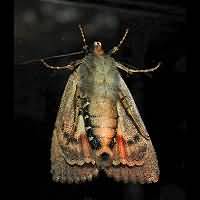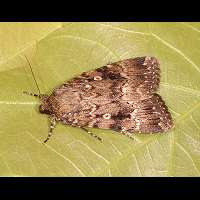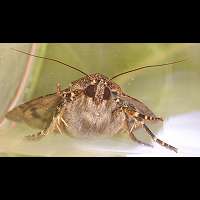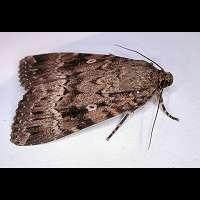Copper Underwing Amphipyra pyramidea
The Copper Underwing is a big and striking species, especially when showing its orange underwing. There is only one similar species, but alas it is almost identical: Svensson's Copper Underwing. There are a few very subtle differences in the markings on the upperwings, but these are hard to see and do not always provide you with certainty. The underwing and the body of the Copper Underwing are more contrasting than those of Svensson's Copper Underwing, which is more or less a good method of telling them apart. Yet seeing which is which is sometimes difficult even for experts. In both species the small and white outlined circular spot may be absent. The Copper Underwing reaches a wingspan of 47 to 54mm.
The eggs are being laid from September onwards on twigs or the bark of the foodplant. They are deposited either one by one or in very small groups. They overwinter and hatch next spring. The caterpillars are found in April and May mainly. In June they go underground, where they spin a cocoon in which pupation takes place. After some two months the new adults appear. The caterpillar is bold and green and has a hump on the 11th segment. This hump ends in a triangular point. This point is yellow in the Copper Underwing and red in Svensson's. Over the spiracula runs a striking line. It consists of two colours: the upper part is green, the lower part is white. This line is not visible on segments 4 and 5. The caterpillar reaches a length of 37 to 42mm. It lives on various deciduous trees, such as oak, honeysuckle and ash.
The Copper Underwing is on the wing from August to mid-October. It is attracted to light, but more so by sugar. In the wild often seen sucking on bleeding trees. Very keen visitors to gardens with Buddleija. It flies by night only, but is regularly encountered during the day, resting in crevices of bark, nesting boxes, sheds or even homes. Often you will see them resting in small groups consisting of Copper Underwings and Svennson's Copper Underwings. Is easily photographed when resting. Some specimens can be handled as well, others fly off very quickly. Common in the southern half of England and Wales, but also common in the Midlands and in Ireland. Elsewhere scarce, but found as far north as Morayshire. Very common on the continent as well, except for the far north.
The Copper Underwing is a big and striking species, especially when showing its orange underwing. There is only one similar species, but alas it is almost identical: Svensson's Copper Underwing. There are a few very subtle differences in the markings on the upperwings, but these are hard to see and do not always provide you with certainty. The underwing and the body of the Copper Underwing are more contrasting than those of Svensson's Copper Underwing, which is more or less a good method of telling them apart. Yet seeing which is which is sometimes difficult even for experts. In both species the small and white outlined circular spot may be absent. The Copper Underwing reaches a wingspan of 47 to 54mm.
The eggs are being laid from September onwards on twigs or the bark of the foodplant. They are deposited either one by one or in very small groups. They overwinter and hatch next spring. The caterpillars are found in April and May mainly. In June they go underground, where they spin a cocoon in which pupation takes place. After some two months the new adults appear. The caterpillar is bold and green and has a hump on the 11th segment. This hump ends in a triangular point. This point is yellow in the Copper Underwing and red in Svensson's. Over the spiracula runs a striking line. It consists of two colours: the upper part is green, the lower part is white. This line is not visible on segments 4 and 5. The caterpillar reaches a length of 37 to 42mm. It lives on various deciduous trees, such as oak, honeysuckle and ash.
The Copper Underwing is on the wing from August to mid-October. It is attracted to light, but more so by sugar. In the wild often seen sucking on bleeding trees. Very keen visitors to gardens with Buddleija. It flies by night only, but is regularly encountered during the day, resting in crevices of bark, nesting boxes, sheds or even homes. Often you will see them resting in small groups consisting of Copper Underwings and Svennson's Copper Underwings. Is easily photographed when resting. Some specimens can be handled as well, others fly off very quickly. Common in the southern half of England and Wales, but also common in the Midlands and in Ireland. Elsewhere scarce, but found as far north as Morayshire. Very common on the continent as well, except for the far north.








